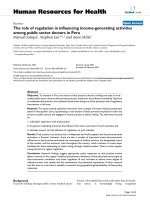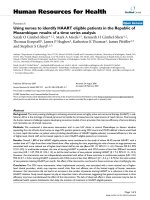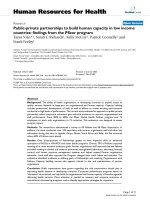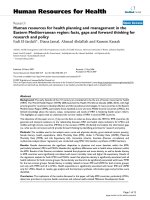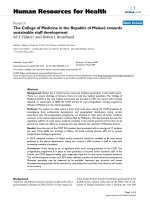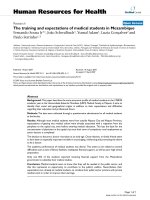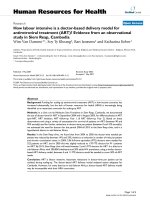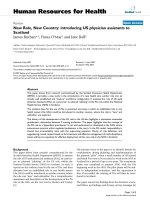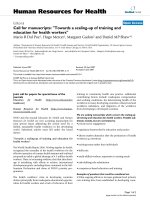Báo cáo sinh học: "Marine pollution: let us not forget beach sand" docx
Bạn đang xem bản rút gọn của tài liệu. Xem và tải ngay bản đầy đủ của tài liệu tại đây (180.7 KB, 14 trang )
This Provisional PDF corresponds to the article as it appeared upon acceptance. Fully formatted
PDF and full text (HTML) versions will be made available soon.
Marine pollution: let us not forget beach sand
Environmental Sciences Europe 2011, 23:40 doi:10.1186/2190-4715-23-40
Francois Galgani ()
Katrin Ellerbrake ()
Elke Fries ()
Chantal Goreux ()
ISSN 2190-4715
Article type Discussion
Submission date 28 September 2011
Acceptance date 20 December 2011
Publication date 20 December 2011
Article URL />This peer-reviewed article was published immediately upon acceptance. It can be downloaded,
printed and distributed freely for any purposes (see copyright notice below).
For information about publishing your research in Environmental Sciences Europe go to
/>For information about other SpringerOpen publications go to
Environmental Sciences Europe
© 2011 Galgani et al. ; licensee Springer.
This is an open access article distributed under the terms of the Creative Commons Attribution License ( />which permits unrestricted use, distribution, and reproduction in any medium, provided the original work is properly cited.
- 1 -
Marine pollution: let us not forget beach sand
Francois Galgani
1
, Katrin Ellerbrake
2
, Elke Fries*
2
and Chantal Goreux
3
1
Institut français de recherche pour l'exploitation de la mer (Ifremer), Laboratoire
Environnement Ressources (LER)/Provence Azur Corse (PAC), ZI Furiani, Bastia,
20200, France
2
Institute of Environmental Systems Research, University of Osnabrueck,
Osnabrueck, 49076, Germany
3
Total Petrochemicals Research Feluy, Feluy, 7181, Belgium
*Corresponding author:
Email addresses:
FG:
KE:
EF:
CG:
- 2 -
Abstract
Background: Assessing the chemical or bacterial contamination in marine waters and
sediments is a very common approach to evaluate marine pollution and associated
risks. However, toxicity and organic pollution of beach sands have not yet been
considered, except in adjacent waters. In the present study, the toxicity and the
chemical contamination of natural beach sands collected 20 m from the shoreline at
two sites located on the Mediterranean Sea (Marseille and La Marana, Corsica) were
studied.
Results: Up to 16.93% (net percentage) abnormal or dead larvae was observed in
elutriates prepared from the urban beach sand sample (Marseille); no significant
toxicity was observed in the sample collected from the reference beach in La Marana.
Results of Fourier transform infrared spectroscopy analyses revealed that no
microplastics were present in either of the samples. Several polycyclic aromatic
hydrocarbons [PAHs] in both samples and a larger number of individual PAHs in the
urban sample than in the sample collected from the reference beach were detected. In
addition, the antioxidant dioctyldiphenylamine was detected in both beach sand
samples, whereby a higher concentration was found in La Marana than in Marseille.
Calculated PAH concentrations in elutriates were generally higher than measured
ones.
Conclusions: The results of this preliminary study provide evidence of toxicity and
the presence of organic trace contaminants in beach sands from France. According to
our results, monitoring using a combination of biotests and chemical analyses is
recommended, especially of sediments from beaches abandoned to urban and
industrial areas.
Keywords: oyster larvae biotests; sediments; infrared spectroscopy; gas
chromatography-mass spectrometry; microplastics; polycyclic aromatic
hydrocarbons; Mediterranean Sea; bioavailability; organic contaminants.
Background
Assessing the chemical or bacterial contamination in marine waters, sediments and
organisms is a very common approach to evaluate marine pollution and associated
risks [1-7]. In addition, the impact of plastic debris on the chemical contamination of
marine ecosystems following the sorption of organic contaminants from seawater or
the release of organic plastic additives has been discussed recently [8-10]. Sorption to
sediments is the main process that determines the fate of hydrophobic organic
compounds in the marine environment. Organic carbon has been shown to be a
significant factor in controlling the sorption process [11-13]. Although organic
chemicals and heavy metals accumulate in organisms living in/on the sand or on
sandy eggs [14, 15], the contamination of beaches is not normally considered, except
in adjacent waters. This might be due to the lower extent of organic materials in beach
sediments prone to pollution by organic contaminants. As with many other organic
contaminants, some specific compounds, such as anti-UV agents, have been described
in marine organisms [16], but not in beach sands, where their occurrence is also
expected. Surprisingly, and to our knowledge, no information is available on the
toxicity and the presence of organic trace contaminants in natural beaches.
- 3 -
In addition to toxicity tests, the potential for risk may be typically assessed
using the proportion of dose estimated to penetrate through exposed skin [17].
However, this approach is still under development. In addition, only recommended
values exist for adverse biological effects on organisms living in marine and estuarine
sediments [18, 19].
From an environmental perspective, knowledge of the extent to which beaches
are contaminated could lead not only to the evaluation of the levels and trends of
contaminants, but also, following human contact with sand, to an assessment of the
effects on public health. More fundamentally, these measurements should also specify
fluxes of contaminants at the interface between coasts and seawater.
In the present study, beach sands were collected from two sites on the
Mediterranean Sea in France (Marseille and La Marana, Corsica) and studied for
toxicity and chemical pollution. The samples were analysed by Fourier transform
infrared [FTIR] spectroscopy to assess the presence of microplastics. Polycyclic
aromatic hydrocarbons [PAHs] - a class of hydrophobic organic chemicals - were
analysed due to their widespread occurrence and persistence in the environment and
their toxic and carcinogenic properties [20] with sufficient evidence from animal
studies [21]. PAHs are widely found in surface soils, where typical concentrations
range from 5 to 100 µg/kg in forests and 600 to 3,000 µg/kg in urban areas [21].
However, no guidelines on PAHs for beaches or non-industrial soils have ever been
described in relation to their effects on human health.
Results
Biotests
The larval development of the oyster Crassostrea gigas was tested for 24 h, until
stage D was reached, in the presence of various concentrations of elutriates prepared
from beach sands collected at both sites, Marseille and La Marana (Figure 1). After 24
h, we found up to 16.93 ± 7.14% (net percentage, two test series times three replicates
each) abnormal or dead larvae in 100% elutriates prepared from the sediment sample
collected in Marseille by seawater extraction. In the sample collected from the
reference beach (La Marana), no significant toxicity was observed (0.87 ± 0.74%, net
percentage, two test series times three replicates each).
FTIR spectroscopy analysis
FTIR spectroscopy was used to test whether microplastics occur in the beach sands.
CH
2
groups were found only in the beach sand collected from La Marana. Moreover,
no signal was found in this sample after all CH
2
groups were removed following
extraction using tetrachloromethane.
GC-MS analysis
Concentrations of PAHs measured in the beach sand samples are shown in Table 1.
The following PAHs (including several EPA-PAHs) were detected in the urban
sample (Marseille): acenaphthylene [ACY], acenaphthene [ACE], phenanthrene
[PHE], anthracene [ANT], fluoranthene [FLT], pyrene [PYR], benz(a)anthracene
[BAA], chrysene [CHR], benzo(b)fluoranthene [BBF], benzo(k)fluoranthene [BKF],
benzo(e)pyrene [BEP], benzo(a)pyrene [BAP], indeno(1,2,3-cd)pyrene [IPY],
dibenz(a,h)anthracene [DBA] and benzo(ghi)perylene [BPE]. The total PAH
concentration in the urban sample was 539 µg/kg dry weight [dwt]. The
concentrations of individual PAHs were between 1.52 (ACE) and 101 µg/kg dwt
- 4 -
(PHE). In the sediment sample collected from La Marana, only three individual PAHs
were detected (ACE, BAP, IPY) with a much lower total of 1.56 µg/kg dwt (Table 1).
Concentrations of PAH in elutriates prepared from the sediment samples
collected at both sites and in seawater are shown in Table 2. The limits of detection
[LOD] are also shown. Since most PAHs in elutriates and seawater used for sediment
extraction were below the limits of quantitation [LOQ] and LOD, with the exception
of PYR, BAA and CHR in the elutriate prepared from the sediment sample from
Marseille, the equilibrium concentrations in the elutriates were calculated. The results
are shown in Table 3. The calculated PAH levels in elutriates obtained from the
sediment samples in Marseille and La Marana were between 0.07 (DBA) and 426
ng/L (ACY; sum of PAHs 677 ng/L) and between 0.01 (BAP, IPY) and 4.26 ng/L
(ACY; sum of PAHs 4.28 ng/L), respectively. Since agitation was performed for 8 h,
equilibrium could be assumed, and much lower measured PAH concentrations than
calculated ones might be attributed to a loss of compounds during elutriate
preparation. Dioctyldiphenylamine - an antioxidant in oils, lubricants, rubber and
plastics - was also identified in both samples, whereby the concentration in La Marana
(>100 µg/kg dwt) was higher than that in Marseille (>0.3 µg/g dwt).
Discussion
From our study on sand samples collected from two beaches, evidence of toxicity was
found in a beach sand aqueous extract. The occurrence of abnormal larvae in the
course of larval development in the extract from Marseille could be linked to the
occurrence of contaminants in the sediments. The non-specific test is used to measure
the overall impact of contaminants. Although the toxicity rate is low compared to
immersed sediments from industrial areas or towns [22, 23], it is significant and in the
same range as some affected areas such as coastal lagoons and bays [24]. It is difficult
to draw any conclusions on the basis of these results with regard to the source and
nature of the contaminants involved. However, the results suggest the presence of
bioavailable toxic contaminants.
Several organic plastic additives, such as phthalates, organotins, bisphenol A
and polybrominated diphenyl ethers, and chemicals sorbed to plastics, such as PAHs
and polychlorinated biphenyls, have potentially toxic or endocrine effects [9, 10, 25].
Migration of such chemicals into elutriates or the direct ingestion of microplastics by
oyster larvae followed by leaching into the organisms could be a possible explanation
for the observed toxic effect. From our results of FTIR spectroscopy analysis, it can
be assumed that CH
2
groups in the beach sands were long-chain hydrocarbons and
that no plastic polymers were present in beach sands from either of the sampling
locations. The absence of microplastics in the sediment samples suggests the
existence of bioavailable fractions of organic contaminants in the sediments collected
in Marseille.
The detection of PAHs in both sediment samples indicated that beach sands
are a possible sink for such hydrophobic chemicals. The occurrence of PAHs in both
samples must be due primarily to atmospheric deposition because samples were taken
from areas that had not been flooded for some time. Possible PAH emission sources
are car and truck traffic, industrial activities using fuel oils and the combustion of
coal/coke (iron and steel industries). In addition, aerosols from the sea may also
contribute to the PAH burden in beach sands, especially following stormy weather, as
hydrophobic compounds accumulate at the surface, albeit to a lesser extent [26]. The
sum of PAH concentrations in the urban sample (Marseille) was within the lower
range found in immersed sediments from Marseille Bay, France [7] and Dar es
- 5 -
Salaam, Tanzania [3], but higher than in coastal sediments from Togo [5]. In the study
by Benlahcen et al. [6], the sum of PAHs was usually higher in Mediterranean coastal
sediments than that found in the urban sample of the present study.
PAH ratios, such as ANT/(ANT + PYR) (mass 178), FLT/(FLT + PYR) (mass
202) and BAA/(BAA + CHR) (mass 228), are commonly used to characterise types of
PAH sources in soils [27] and river sediments [28]. The ANT/178 ratio of 0.04
calculated for the sediment sample collected in Marseille was lower than 0.1,
indicating petrogenic sources. On the other hand, the FLT/202 ratio of 0.7 suggests
pyrogenic sources of PAHs, such as kerosene, grass, coal and wood combustion [28,
29]. A BAA/228 ratio of 0.5 supports this suggestion [28]. The petrogenic origin of
PAHs is unlikely for the selected sampling locations because samples were collected
20 m from the shoreline where flooding had never occurred. The usefulness of
ANT/178 ratio as a recipient matrix has already been called into question before for
soil [13, 27].
Previous studies on marine sediments and caged mussels [7, 24] have
demonstrated the different PAH contamination at both sites. Differences in the PAH
burden of both samples are explained by the large number of PAH sources in the Bay
of Marseille, including maritime activities, refineries, traffic and urbanisation,
whereas the reference station La Marana, which has an adjacent open sea, is
unaffected by local sources.
The larger number of individual PAHs and the higher sum of PAHs measured
in the urban sediment sample (Marseille) compared to the sample from the reference
beach (La Marana) indicate that abnormal or dead oyster larvae may result from
bioavailable fractions of PAHs. Toxic effects of PAHs on oyster larvae have been
reported for a total elutriate PAH concentration of 940 ng/L [30]. The total PAH
concentration measured in the elutriate obtained from the sample from Marseille was
much lower (Table 3). Although the toxic effect was also lower, these results might
also indicate effects of other unknown chemicals.
Since the bioavailable fraction of dioctyldiphenylamine is expected to be very
low according to the very high estimated octanol-water partition coefficient (log K
ow
)
of 11.26 [31], it is rather unlikely that the observed toxic effect was caused by this
compound. However, this non-polar chemical is not readily biodegradable, suggesting
its potential to persist in the environment [31]. Hence, more data on its occurrence in
sediments and its bioavailability are required. However, other contaminants that could
not be detected using the GC-MS methods applied, such as metals or more polar
organic compounds, may also be involved.
Conclusions
This first evidence of toxicity and the presence of organic contaminants, such as
PAHs and dioctyldiphenylamine in beach sands, raise important questions that need to
be addressed in the future by the scientific community. Further investigations into
toxic chemicals in beach sands are recommended in combination with biotests,
especially at beaches in the vicinity of urban, industrial and tourist areas. In addition,
the question whether aerosols from the sea may be a source of organic pollutants in
beach sand should be addressed in future research. The problem of toxicity due to
organic contaminants in beach sands will be of broad interest to stakeholders,
policymakers and the general public. The abundance of such toxic chemicals as PAHs
in beach sand is also of concern from a health perspective since most beaches are
frequented by tourists. In addition to providing new insights into marine pollution,
evaluating the problem on a larger scale may also help to create a new, simple method
- 6 -
of monitoring the state of the environment, environmental quality standards and
guidelines.
Methods
Sampling
One sand sample made of ten pooled fractions from a 10 × 10-m area was collected
from the top 2 cm of an urban beach in Marseille (France) and compared with a
reference beach in La Marana (Corsica, France). Both sampling locations were 20 m
from the shoreline. Marseille was chosen because it is a large urban, industrial and
coastal area with various pollution sources. Marseille and the surrounding area are
home to more than 1.2 × 10
6
inhabitants. The Rhone river delta is adjacent (west) to
the city. This is one of the areas affected most severely by contamination in the
Mediterranean, especially by PAHs [32]. The sampling location at La Marana was
selected as a background station. It is located south of the city Bastia (30 × 10
3
inhabitants) and has no industry, but tourist activities. Beach sand samples were
placed in 100-mL brown glass bottles (Omnilab, Hannover, Germany) precleaned
using methanol (HPLC grade, Merck, Darmstadt, Germany) and ultrapure water taken
from an Arium 611VF water purification system (Sartorius, Goettingen, Germany).
The caps were equipped with Lupolen inserts (Omnilab) wrapped in an aluminium
foil. Sediment samples were kept frozen until the chemical analysis was undertaken.
Biotests
The toxicity of the beach sand samples was assessed using oyster larvae biotests [33].
Sands were agitated for 8 h after adding filtered seawater (4:1 volume/weight) and
decanted for 4 h. Biotests were performed at the Institute Pasteur Lille (IPL), France
by exposing oyster embryo larvae to five concentrations of elutriates prepared from
both samples (20%, 40%, 60%, 80% and 100% elutriates + control). Elutriates were
stored at +4°C until the chemical analysis was undertaken. Mature genitors (C. gigas)
were obtained from the Guernsey Sea Farms hatchery. These genitors were carefully
cleaned and immersed in unfiltered reference water at 18°C for 30 min before a
thermal shock (28°C, 30 min). After the emission of gametes, fecundation was
monitored under a microscope; then, after dilution, the larvae were transferred to
Iwaki microplates (final volume 3 mL, number 300 larvae/well) and placed in culture
with sand extracts at 24 ± 1°C for 24 h. After incubation and after reaching the typical
stage D [33], the larvae were fixed in 4% formaldehyde and decanted. The
abnormality rate, including dead larvae, was determined on the basis of a count of 100
larvae/well (two tests, three replicates per concentration). Abnormalities in controls
were 6.16 ± 2.4%. The results are given as the net percentage of abnormalities
(toxicity minus toxicity of control The dose/response relationship was obtained using
the REGTOX: macro Excel [34].
FTIR spectroscopy analysis
Air-dried beach sand samples were analysed using FTIR spectroscopy with an
infrared spectrometer and ATR MIRacle (attenuated total reflection; PIKE
Technologies, Madison, WI, USA) with a diamond crystal [35]. The system enabled
to analyse the surface of the sand for the presence of CH
2
-related organic compounds
or only polymers after tetrachloromethane (CCl
4
) extraction. The depth penetration of
light in the samples was 4 µm. Sensitivity tests were made with pure sand washed
with demineralised water and spiked with micronized polyethylene (Total
- 7 -
Petrochemicals, Feluy, Belgium). It was checked that 0.01% and 0.1% of the
micronized polyethylene can be clearly detected.
GC-MS analysis
The beach sand samples were analysed for the presence of organic contaminants using
Soxhlet extraction followed by gas chromatography-mass spectrometry [GC-MS]. All
sand samples were freeze-dried. To determine the procedural blank, one aliquot (10 g)
was precleaned with dichloromethane [DCM] (HPLC grade, Promochem, Wesel,
Germany) for 12 h in a Soxhlet extractor. Aliquots of 10 g were spiked with 100 µL
of a deuterated PAH standard solution containing acenaphthene-D
10
, chrysene-D
10
,
perylene-D
12
and phenanthrene-D
12
(Dr. Ehrenstorfer GmbH, Augsburg, Germany)
with a concentration of 5 ng/µL in acetone using an aluminium laboratory spoon.
During mixing, contact between the spoon and the solution was strictly avoided. The
samples were extracted for 12 h in the Soxhlet extractor. The solvent was evaporated
to dryness and dissolved again in 100 µL DCM. Eight microlitres of a standard
solution containing fluazifop-butyl (Sigma-Aldrich, Seelze, Germany) in methanol
(HPLC grade, Promochem) were added to the final extracts as a recovery standard.
One microlitre of the extracts was injected into a GC injector. GC analyses
were performed on a 6890N GC system coupled with a 5973 inert mass selective
detector (Agilent Technologies, Santa Clara, CA, USA). An HP-5MS capillary
column (5% diphenyl-95% dimethylpolysiloxane), 30 m in length × 0.25 mm in inner
diameter and 0.25 µm in film thickness (Agilent Technologies), was used for
chromatographic separation. The GC programme was as follows: 80°C (held for 5
min), then at 15°C/min to 180°C followed by 5°C/min to 310°C (held for 5 min).
Helium was used as the carrier gas at a flow rate of 1.5 mL/min. Identification of
compounds was carried out by comparing the mass spectrum collected from the Wiley
library and retention times and mass spectra to those obtained from the analyses of
authentic standards (PAHs were purchased from Neochema, Bodenheim, Germany;
dioctyldiphenylamine was purchased from Chemos GmbH, Regenstauf, Germany).
Quantification of PAHs was performed by calculating the peak area ratios of the
individual PAHs and selected deuterated PAHs corrected by a factor resulting from
different recoveries. The procedural blanks for PAHs were between 0.28 (BAA) and
4.04 µg/kg (PHE). The LOD were either determined by blanks or by a peak-to-noise
ratio of 3:1. The LOQ were set at three times the LOD.
PAHs were also analysed in elutriates (7 mL) using solid-phase
microextraction and GC-MS. A one-aliquot sample of seawater used for sediment
extraction was also analysed. Tap water was analysed as a blank of the whole
procedure. Nine microlitres of the deuterated PAH standard solution with a
concentration of 50 pg/µL in acetone was added to the samples as an internal
standard. The method was described in detail in Kukučka et al. [36]. The LOD were
either determined by blanks or by a peak-to-noise ratio of 3:1. The LOQ were set at
three times the LOD.
The equilibrium concentrations of PAHs in elutriates (C
aq
) were calculated
using Equation 1:
aq d sed
1/ *
C K C
=
, (1)
where K
d
is the sediment-water distribution coefficient and C
sed
is the concentration of
the individual PAH in the sediment.
The K
d
values were obtained from the organic carbon normalised distribution
coefficient (K
oc
) according to Equation 2:
- 8 -
d oc oc
*
K K f
=
,
(2)
where f
oc
is the fraction of organic carbon [OC] in the sediment. The mean values of
f
oc
(n = 3) in the samples collected from Marseille and La Marana were determined at
0.05 ± 0.001% and 0.002 ± 0.0001%, respectively, using a total OC analyser
(Elementar, Hanau, Germany). According to Wu and Sun [37], the factor between K
d
for seawater and freshwater was 1.21 for PHE. Since no factors exist for the other
PAHs, the effect of the saline solution on K
d
was neglected.
The K
oc
value was determined according to Karickhoff [38] by Equation 3:
oc ow
log 0.989 * log – 0.346
K K=
, (3)
where K
ow
is the octanol-water partition coefficient. The values of K
ow
were taken
from Ma et al. [39].
Competing interests
The authors declare that they have no competing interests.
Authors' contributions
FG conducted the sampling and biotests. EF and KE analysed the organic trace
contaminants, and CG led the IR analyses. All authors read and approved the final
manuscript.
References
1. Claisse D: Chemical contamination of French coasts. The results of a ten years
mussel watch. Mar Poll Bull 1989, 20:523-528.
2. Barbee GC, Barich J, Duncan B, Bickham JW, Matson CW, Hintze CJ, Autenrieth
RL, Zhou GD, McDonald TJ, Cizmas L, Norton D, Donnelly KC: In situ
biomonitoring of PAH-contaminated sediments using juvenile coho salmon
(Oncorhynchus kisutch). Ecotoxicol Environ Saf 2008, 71:454-64.
3. Gaspare L, Machiwa JF, Mdachi SJ, Streck G, Brack W: Polycyclic aromatic
hydrocarbon (PAH) contamination of surface sediments and oysters from the
inter-tidal areas of Dar es Salaam, Tanzania. Environ Pollut 2009, 157:24-34.
4. Fleisher JM, Fleming LE, Solo-Gabriele HM, Kish JK, Sinigalliano CD, Plano L,
Elmir SM, Wang JD, Withum K, Shibata T, Gidley ML, Abdelzaher A, He G,
Ortega C, Zhu X, Wright M, Hollenbeck J, Backer LC: The BEACHES study:
health effects and exposures from non-point source microbial contaminants in
subtropical recreational marine waters. Int J Epidemiol 2010, 39:1291-1298.
5. Gnandi K, Musa Bandowe BA, Deheyn DD, Porrachia M, Kersten M, Wilcke W:
Polycyclic aromatic hydrocarbons and trace metal contamination of coastal
sediment and biota from Togo. J Environ Monit 2011, 13:2033-2041.
6. Benlahcen KT, Chaoui A, Budzinski H, Bellocq J, Garrigues Ph: Distribution and
sources of polycyclic aromatic hydrocarbons in some Mediterranean coastal
sediments. Mar Poll Bull 1997, 34:298-305.
7. Asia L, Mazouz S, Guiliano M, Doumenq P, Mille G: Occurrence and
distribution of hydrocarbons in surface sediments from Marseille Bay
(France). Mar Poll Bull 2009, 58:424-455.
8. Endo S, Takizawa R, Okuda K, Takada H, Chiba K, Kanehiro H, Ogi H, Yamashita
R, Date T: Concentration of polychlorinated biphenyls (PCBs) in beached
resin pellets: variability among individual particles and regional differences.
Mar Poll Bull 2005, 44:1103-1114.
- 9 -
9. Teuten EL, Saquing JM, Knappe DRU, Barlaz MA, Jonsson, S, Björn A, Rowland
SJ, Thompson RC, Galloway TS, Yamashita R, Ochi D, Watanuki Y, Moore C,
Viet PH, Tana TS, Prudente M, Boonyatumanond R, Zakaria MP, Akkhavong K,
Ogata Y, Hirai H, Iwasa S, Mizukawa K, Hagino Y, Imamura A, Saha M, Takada
H: Transport and release of chemicals from plastics to the environment and to
wildlife. Phil Trans R Soc B 2009, 364:2027-2045.
10. Hirai H, Takada H, Ogata Y, Yamashita R, Mizukawa K, Saha M, Kwan C,
Moore C, Gray H, Laursen D, Zettler E R, Farrington JW, Reddy CM, Peacock
EE, Ward MW: Organic micropollutants in marine plastics debris from the
open ocean and remote and urban beaches. Mar Poll Bull 2011, 62:1683-
1692.
11. Goring CAI: Control of nitrification by 2-chloro-6-(trichloro-methyl)
pyridine. Soil Science 1962, 93:211-218.
12. Goring CAI, Hamaker JW: Organic Chemicals in the Soil Environment. Volume I.
New York: Marcel Dekker Inc.; 1972.
13. Bucheli TD, Blum F, Desaules A, Gustafsson Ö: Polycyclic aromatic
hydrocarbons, black carbon, and molecular markers in soils of Switzerland.
Chemosphere 2004, 56:1061-1076.
14. Ungherese G, Ugolini A: Sandhopper solar orientation as a behavioural
biomarker of trace metals contamination. Environ Poll 2009, 157:1360-1364.
15. Vidal M, Domínguez J, Luís A: Spatial and temporal patterns of polycyclic
aromatic hydrocarbons (PAHs) in eggs of a coastal bird from northwestern
Iberia after a major oil spill. Sci Total Environ 2011, 409:2668-2673.
16. Brown S: Sunscreen wipes out corals. Nature 2008. doi:10.1038/news.2008.537.
17. Knafla A, Petrovic S, Richardson M, Campbell J, Rowat C: Development and
application of a skin cancer slope factor for exposures to benzo[a]pyrene in
soil. Regul Toxicol Pharmacol 2011, 59:101-110.
18. Cachot J, Geffard O, Augagneur S, Lacroix S, Le Menach K, Peluhet L, Couteau
J, Denier X, Devier M, Pottier D, Budzinski H: Evidence of genotoxicity
related to high PAH content of sediments in the upper part of the Seine
estuary (Normandy, France). Aquat Toxicol 2006, 79:257-267.
19. OSPAR: CEMP Assessment Report: 2008/2009 Assessment of Trends and
Concentrations of Selected Hazardous Substances in Sediments and Biota.
London; 2009.
20. Douben PET: PAHs: An Ecotoxicological Perspective (Ecological &
Environmental Toxicology Series). West Sussex: John Wiley & Sons; 2003.
21. WHO: Health Risks of Persistent Organic Pollutants from Long-range
Transboundary Air Pollution. Copenhagen; 2003.
22. Dalmazzone C, Blanchet D, Lamoureux S, Durrieu J, Dutrieux E, Camps R,
Galgani F: Impact of drilling activities in warm sea: re-colonization
capacities of seabed. Oil Gas Sci Technol 2004, 59:625-647.
23. Galgani F, Chiffoleau JF, Orsoni V, Costantini L, Boissery P, Calendini S, Andral
B: Chemical contamination and toxicity of sediments from coastal areas of
Corsica islands. Chem Ecol 2006, 22:299-312.
24. Galgani F, Senia J, Guillou JL, Laugier T, Munaron D, Andral B, Guillaume B,
Coulet E, Boissery P, Brun L, Bertrandy MC: Assessment of the environmental
quality of French continental Mediterranean lagoons with oyster embryo
bioassay. Arch Environ Contam Toxicol 2009, 57:540-551.
- 10 -
25. Fries E, Zarfl C: Sorption of polycyclic aromatic hydrocarbons (PAHs) to low
and high density polyethylene (PE). Environ Sci Poll Res 2011. doi:
10.1007/s11356-011-0655-5.
26. Guigue C, Tedetti M, Giorgi S, Goutx M: Occurrence and distribution of
hydrocarbons in the surface microlayer and subsurface water from the
urban coastal marine area off Marseilles, Northwestern Mediterranean Sea.
Mar Poll Bull 2011. doi:10.1016/j.marpolbul.2011.09.013.
27. Brändli, RH, Bucheli, TD, Ammann S, Desaules A, Keller A, Blum F, Stahel
WA: Critical evaluation of PAH source apportionment tools using data from
the Swiss soil monitoring network. J Environ Monit 2008, 10:1278-1286.
28. Yunker MB, Macdonald RW, Vingarzan R, Mitchell RH, Goyette D, Sylvestre S:
PAHs in the Fraser River basin: a critical appraisal of PAH ratios as
indicators of PAH source and composition. Org Geochem 2002, 33:489-515.
29. Budzinski H, Jones I, Bellocq J, Piérard C, Garrigues P: Evaluation of sediment
contamination by polycyclic aromatic hydrocarbons in the Gironde estuary.
Mar Chem 1997, 58:85-97.
30. Geffard O, Geffard A, His E, Budzinski H: Assessment of the bioavailability
and toxicity of sediment-associated polycyclic aromatic hydrocarbons and
heavy metals applied to Crassostrea gigas embryos and larvae. Mar Poll Bull
2003, 46:481-490.
31. USEPA (United States Environmental Protection Agency): Screening-level
Hazard Characterization for High Production Volume Chemicals: Substituted
Diphenylamines. Washington, DC; 2008.
32. Galgani F, Martinez-Gomez C, Giovanardi F, Romanelli G, Calvo M, Caixap J,
Cento A, Scarpato A, Benbrahim S, Sammari C, Deudero S, Boulahdid M,
Andral B: Assessment of polycyclic aromatic hydrocarbon concentrations in
mussels (Mytilus galloprovincialis) from the North West basin of the
Mediterranean Sea (the Mylilos project). Environ Monit Assess 2011,
172:301-317.
33. His E, Seaman M, Beiras R: A simplification of the bivalve embryogenesis
larval development bioassay method for water quality assessment. Water Res
1997, 31:351-355.
34. REGTOX [ />]
35. Coleman PP: Practical Sampling Techniques for Infrared Analysis. Boca Raton:
CRC Press; 1993.
36. Kukučka P, Lammel G, Dvorská A, Klánová J, Möller A, Fries E:
Contamination of Antarctic snow by polycyclic aromatic hydrocarbons
dominated by combustion sources in the polar region. Environ Chem 2010,
7:504-513.
37. Wu W, Sun H: Sorption-desorption of phenanthrene - effect of nanopores,
solute concentration, and salinity. Chemosphere 2010, 81:961-967.
38. Karickhoff SW: Semi-empirical estimation of sorption of hydrophobic
pollutants on natural sediments and soils. Chemosphere 1981, 8:833-846.
39. Ma Y-G, Lei YD, Xiao H, Wania F, Wang W-H: Critical review and
recommended values for the physical-chemical property data of 15
polycyclic aromatic hydrocarbons at 25°C. J Chem Eng Data 2010, 55:819-
825.
- 11 -
Figure 1. Effects of sand extracts from Marseille and La Marana on larval
development of C. gigas. Toxicity is expressed as the percentage of abnormal larvae
(net percentage, toxicity minus control) after 24-h development in various
concentrations of beach sand extracts (elutriates). EC
15
(99.60%) is the elutriate
concentration causing 15% of abnormalities. Empty squares, mean values; filled
circle, Marseille; filled triangle, La Marana.
Table 1. Concentrations of PAHs measured in beach sand samples collected from
Marseille and La Marana
Compound M (µg/kg dwt) LM (µg/kg dwt)
NAP <LOD <LOD
ACY 61.7 <LOD
ACE 1.52 0.77
FLN <LOD <LOD
PHE 101 <LOD
ANT 4.48 <LOD
FLT 61.6 <LOD
PYR 29.0 <LOD
BAA 27.5 <LOD
CHR 27.4 <LOD
BBF 16.3 <LOD
BKF 36.0 <LOD
BEP 37.4 <LOD
BAP 52.2 0.31
IPY 29.4 0.48
DBA 7.76 <LOD
BPE 45.6 <LOD
∑PAHs 539 1.56
M, Marseille; LM, La Marana; NAP, naphthalene; ACY, acenaphthylene; ACE,
acenaphthene; FLN, fluorene; PHE, phenanthrene; ANT, anthracene; FLT,
fluoranthene; PYR, pyrene; BAA, benz(a)anthracene; CHR, chrysene; BBF,
benzo(b)fluoranthene; BKF, benzo(k)fluoranthene; BEP, benzo(e)pyrene; BAP,
benzo(a)pyrene; IPY, indeno(1,2,3-cd)pyrene; DBA, dibenz(a,h)anthracene; BPE,
benzo(ghi)perylene; ∑PAHs, summation of polycyclic aromatic hydrocarbons; LOD,
limits of detection; LOQ, limits of quantitation.
Table 2. Measured concentrations of PAHs in elutriates prepared from beach
sand samples and in seawater
Compound LOD (ng/L) M (ng/L) LM (ng/L) SW (ng/L)
NAP 2.25 <LOD 2.25 <LOD
ACY 0.44 <LOD 0.44 <LOD
ACE 0.93 <LOD 0.93 <LOD
FLN 0.46 <LOD 0.46 <LOD
PHE 1.67 <LOQ 1.67 <LOQ
ANT 0.13 <LOD 0.13 <LOD
FLT 5.14 <LOQ 5.14 <LOQ
PYR 0.76 6.59 0.76 6.59
BAA 0.51 1.74 0.51 1.74
- 12 -
CHR 0.50 2.60 0.50 2.60
BBF 0.53 <LOD 0.53 <LOD
BKF 0.53 <LOD 0.53 <LOD
BEP 0.35 <LOD 0.35 <LOD
BAP 0.70 <LOD 0.70 <LOD
IPY 0.57 <LOD 0.57 <LOD
DBA 1.46 <LOD 1.46 <LOD
BPE 1.02 <LOD 1.02 <LOD
LOD, limits of detection; M, Marseille; LM, La Marana; SW, seawater; NAP,
naphthalene; ACY, acenaphthylene; ACE, acenaphthene; FLN, fluorene; PHE,
phenanthrene; ANT, anthracene; FLT, fluoranthene; PYR, pyrene; BAA,
benz(a)anthracene; CHR, chrysene; BBF, benzo(b)fluoranthene; BKF,
benzo(k)fluoranthene; BEP, benzo(e)pyrene; BAP, benzo(a)pyrene; IPY,
indeno(1,2,3-cd)pyrene; DBA, dibenz(a,h)anthracene; BPE, benzo(ghi)perylene.
Table 3. Calculated equilibrium concentrations of the PAHs in elutriates
prepared from beach sand samples
Compound M (ng/L) LM (ng/L)
NAP - -
ACY 426 -
ACE 8.38 4.26
FLN - -
PHE 170 -
ANT 6.00 -
FLT 33.2 -
PYR 14.3 -
BAA 2.09 -
CHR 3.00 -
BBF 1.16 -
BKF 2.55 -
BEP 0.71 -
BAP 2.41 0.01
IPY 0.42 0.01
DBA 0.07 -
BPE 0.56 -
∑PAHs 677 4.28
M, Marseille; LM, La Marana; SW, seawater; NAP, naphthalene; ACY,
acenaphthylene; ACE, acenaphthene; FLN, fluorene; PHE, phenanthrene; ANT,
anthracene; FLT, fluoranthene; PYR, pyrene; BAA, benz(a)anthracene; CHR,
chrysene; BBF, benzo(b)fluoranthene; BKF, benzo(k)fluoranthene; BEP,
benzo(e)pyrene; BAP, benzo(a)pyrene; IPY, indeno(1,2,3-cd)pyrene; DBA,
dibenz(a,h)anthracene; BPE, benzo(ghi)perylene; ∑PAHs, summation of polycyclic
aromatic hydrocarbons
Figure 1
